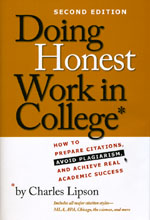Doing honest work in the digital age

For those educated in a less digitized world, what constitutes plagiarism, and what does not, might seem fairly clear cut. But an article in yesterday’s New York Times notes that in an age where copyrighted intellectual property is available for the taking with the click of a button, and citing an original source can often mean digging through layer upon layer of tweets, re-tweets, blog posts, or RSS feeds, many students simply may not grasp the concept. From the Times:
The Internet may… be redefining how students—who came of age with music file-sharing, Wikipedia and Web-linking—understand the concept of authorship and the singularity of any text or image.
“Now we have a whole generation of students who’ve grown up with information that just seems to be hanging out there in cyberspace and doesn’t seem to have an author,” said Teresa Fishman, director of the Center for Academic Integrity at Clemson University. “It’s possible to believe this information is just out there for anyone to take.”
So how does one go about avoiding the ignominious fate of the plagiarist? We recommend picking up a copy of Doing Honest Work in College: How to Prepare Citations, Avoid Plagiarism, and Achieve Real Academic Success, Second Edition and setting it on your bookshelf or desktop right next to the new 16th edition of The Chicago Manual of Style. The CMOS has the rules, but in Lipson’s Doing Honest Work in College you’ll learn more about how to apply them in all academic situations—from paper writing and independent research to study groups and lab work.
Teachers can also use this book to open a discussion with their students about these difficult issues. Students will find a trusted resource for citation help whether they are studying comparative literature or computer science. Every major reference style is represented. Most important of all, many universities that adopt this book report a reduction in cheating and plagiarism on campus.
For this second edition, Charles Lipson has updated hundreds of examples and included many new media sources. There is now a full chapter on how to take good notes and use them properly in papers and assignments. The extensive list of citation styles incorporates guidelines from the American Anthropological Association. The result is the definitive resource on academic integrity that students can use every day.
See a website for the book.